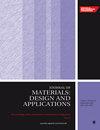Characterization of an additively manufactured coating using an upsetting test with miniaturized cylindrical specimen
IF 2.2
4区 材料科学
Q3 MATERIALS SCIENCE, MULTIDISCIPLINARY
Proceedings of the Institution of Mechanical Engineers, Part L: Journal of Materials: Design and Applications
Pub Date : 2024-08-19
DOI:10.1177/14644207241277406
引用次数: 0
Abstract
In order to reduce CO利用微型圆柱试样进行镦粗试验,确定添加剂制造涂层的特性
为了减少生产过程中的二氧化碳排放量,将多种制造工艺结合起来的做法正逐渐受到重视。其中一个例子就是将金属快速成型技术与成形技术相结合,从而发挥两种工艺技术的优势。例如,这种工艺组合可用于生产混合桶套。使用基于激光的定向能沉积(DED-LB/M)技术,首先在坯料上涂覆一层圆形涂层,然后在第二步中对坯料进行深冲压。添加层用作耐磨涂层。提高对这种工艺组合的工艺理解的方法之一是进行数值模拟。建立仿真模型的一个重要部分是确定材料的机械特性。为了避免较长的构建时间,小尺寸样品适合用于表征添加剂材料。因此,本文使用微型试样进行了镦粗试验,不仅研究了基础材料贝尼杜尔 AM,还研究了碳化钨微粒和碳纳米粒子的添加情况。材料的原位改性显著提高了屈服强度,但同时降低了延展性。添加碳或碳化钨还能提高材料的微硬度。
本文章由计算机程序翻译,如有差异,请以英文原文为准。
求助全文
约1分钟内获得全文
求助全文
来源期刊

CiteScore
4.70
自引率
8.30%
发文量
166
审稿时长
3 months
期刊介绍:
The Journal of Materials: Design and Applications covers the usage and design of materials for application in an engineering context. The materials covered include metals, ceramics, and composites, as well as engineering polymers.
"The Journal of Materials Design and Applications is dedicated to publishing papers of the highest quality, in a timely fashion, covering a variety of important areas in materials technology. The Journal''s publishers have a wealth of publishing expertise and ensure that authors are given exemplary service. Every attention is given to publishing the papers as quickly as possible. The Journal has an excellent international reputation, with a corresponding international Editorial Board from a large number of different materials areas and disciplines advising the Editor." Professor Bill Banks - University of Strathclyde, UK
This journal is a member of the Committee on Publication Ethics (COPE).
 求助内容:
求助内容: 应助结果提醒方式:
应助结果提醒方式:


